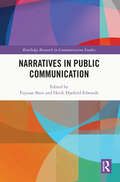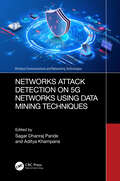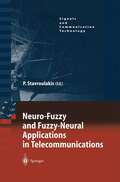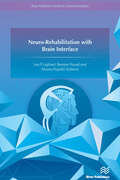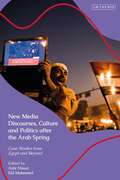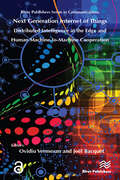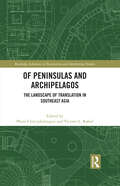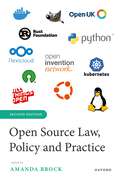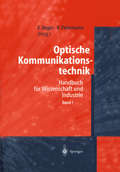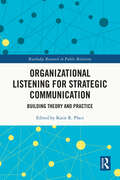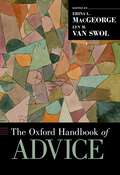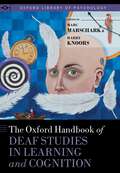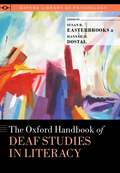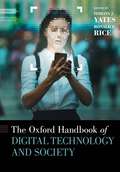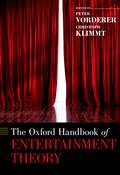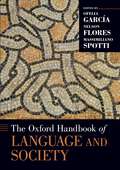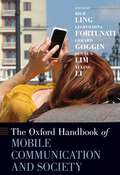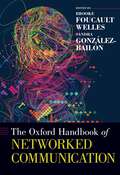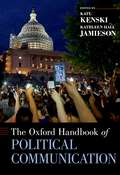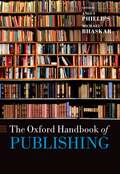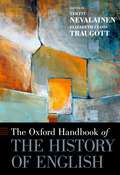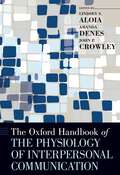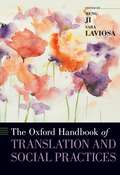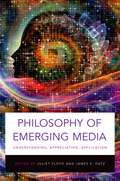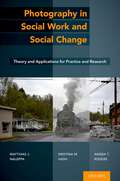- Table View
- List View
Narratives in Public Communication (Routledge Research in Communication Studies)
This volume explores the applications of narrative and storytelling in corporate, public health, and political communications, and its implications for those fields. Using diverse research methods including surveys, experiments, case studies, and content analyses, an international team of authors first explore conceptual and theoretical issues of narrative persuasion, then examine the impact and application of narratives in science communication, political advertising, corporate communication, and social movement before discussing the use of stories in community building, identity construction, and civic engagement. This timely volume will be of interest to academics, researchers, and graduate students who are interested in narratives and communications, within the areas of public relations, public communication, organizational communication, strategic communication, risk and crisis communication, and political communication.
Networks Attack Detection on 5G Networks using Data Mining Techniques (Wireless Communications and Networking Technologies)
Artificial intelligence (AI) and its applications have risen to prominence as one of the most active study areas in recent years. In recent years, a rising number of AI applications have been applied in a variety of areas. Agriculture, transportation, medicine, and health are all being transformed by AI technology. The Internet of Things (IoT) market is thriving, having a significant impact on a wide variety of industries and applications, including e-health care, smart cities, smart transportation, and industrial engineering. Recent breakthroughs in artificial intelligence and machine learning techniques have reshaped various aspects of artificial vision, considerably improving the state of the art for artificial vision systems across a broad range of high-level tasks. As a result, several innovations and studies are being conducted to improve the performance and productivity of IoT devices across multiple industries using machine learning and artificial intelligence. Security is a primary consideration when analyzing the next generation communication network due to the rapid advancement of technology. Additionally, data analytics, deep intelligence, deep learning, cloud computing, and intelligent solutions are being employed in medical, agricultural, industrial, and health care systems that are based on the Internet of Things. This book will look at cutting-edge Network Attacks and Security solutions that employ intelligent data processing and Machine Learning (ML) methods.This book: Covers emerging technologies of network attacks and management aspects. Presents artificial intelligence techniques for networks and resource optimization, and toward network automation, and security. Showcases recent industrial and technological aspects of next-generation networks Illustrates artificial intelligence techniques to mitigate cyber-attacks, authentication, and authorization challenges. Explains smart, and real-time monitoring services, multimedia, cloud computing, and information processing methodologies in 5G networks. It is primarily for senior undergraduates, graduate students and academic researchers in the fields of electrical engineering, electronics and communication engineering, computer engineering, and information technology.
Neuro-Fuzzy and Fuzzy-Neural Applications in Telecommunications (Signals and Communication Technology)
For the first time, this highly interdisciplinary book covers the applications of neuro-fuzzy and fuzzy-neural scientific tools in a very wide area within the communications field. It deals with the important and modern areas of telecommunications amenable to such a treatment.
Neuro-Rehabilitation with Brain Interface
In recent years, major results were reported on Brain-Computer Interface / Brain-Machine Interface (BCI/BMI) applied to rehabilitation in scientific reports and papers. This subject received much attention within the Society on Communication, Navigation, Sensing and Services (CONASENSE) during the period 2013-2015. Describing the state of the art on various BCI/BMI activities related to neuro-rehabilitation is the central theme of this book.The latest insights coming from neurophysiologists, neuropsychologists, ICT experts specialized in clinical data management and from representatives of patient organizations are elucidated and new ways for “BCI/BMI applied to rehabilitation” using advanced ICT are introduced. The book describes the latest progress in and is an appeal for an approach leading to more cost-saving multi-disciplinary neuro-rehabilitation. This book covers the following topics: • Overview on BCI/BMI applied to rehabilitation• ICT for Neuro-rehabilitation• ICT for new generation prostheses• Gaze tracking, facial orientation determination, face and emotion recognition in 3D space for neuro-rehabilitation applications• Integrated perspective for future wide spread integration of motor neuro-rehabilitation• Ethical issues in the use of Information and Communication Technologies in the health care of patients with neurological disorders
New Media Discourses, Culture and Politics after the Arab Spring: Case Studies from Egypt and Beyond
This book investigates the interplay between media, politics, religion, and culture in shaping Arabs' quest for more stable and democratic governance models in the aftermath of the “Arab Spring” uprisings. It focuses on online mediated public debates, specifically user comments on online Arab news sites, and their potential to re-engage citizens in politics. Contributors systematically explore and critique these online communities and spaces in the context of the Arab uprisings, with case studies, largely centered on Egypt, covering micro-bloggers, Islamic discourse online, Libyan nationalism on Facebook, and a computational assessment of online engagement, among other topics.
Next Generation Internet of Things – Distributed Intelligence at the Edge and Human-Machine Interactions
This book provides an overview of the next generation Internet of Things (IoT), ranging from research, innovation, development priorities, to enabling technologies in a global context. It is intended as a standalone in a series covering the activities of the Internet of Things European Research Cluster (IERC), including research, technological innovation, validation, and deployment.The following chapters build on the ideas put forward by the European Research Cluster, the IoT European Platform Initiative (IoT–EPI), the IoT European Large-Scale Pilots Programme and the IoT European Security and Privacy Projects, presenting global views and state-of-the-art results regarding the next generation of IoT research, innovation, development, and deployment.The IoT and Industrial Internet of Things (IIoT) are evolving towards the next generation of Tactile IoT/IIoT, bringing together hyperconnectivity (5G and beyond), edge computing, Distributed Ledger Technologies (DLTs), virtual/ andaugmented reality (VR/AR), and artificial intelligence (AI) transformation.Following the wider adoption of consumer IoT, the next generation of IoT/IIoT innovation for business is driven by industries, addressing interoperability issues and providing new end-to-end security solutions to face continuous treats.The advances of AI technology in vision, speech recognition, natural language processing and dialog are enabling the development of end-to-end intelligent systems encapsulating multiple technologies, delivering services in real-time using limited resources. These developments are focusing on designing and delivering embedded and hierarchical AI solutions in IoT/IIoT, edge computing, using distributed architectures, DLTs platforms and distributed end-to-end security, which provide real-time decisions using less data and computational resources, while accessing each type of resource in a way that enhances the accuracy and performance of models in the various IoT/IIoT applications.The convergence and combination of IoT, AI and other related technologies to derive insights, decisions and revenue from sensor data provide new business models and sources of monetization. Meanwhile, scalable, IoT-enabled applications have become part of larger business objectives, enabling digital transformation with a focus on new services and applications.Serving the next generation of Tactile IoT/IIoT real-time use cases over 5G and Network Slicing technology is essential for consumer and industrial applications and support reducing operational costs, increasing efficiency and leveraging additional capabilities for real-time autonomous systems.New IoT distributed architectures, combined with system-level architectures for edge/fog computing, are evolving IoT platforms, including AI and DLTs, with embedded intelligence into the hyperconnectivity infrastructure.The next generation of IoT/IIoT technologies are highly transformational, enabling innovation at scale, and autonomous decision-making in various application domains such as healthcare, smart homes, smart buildings, smart cities, energy, agriculture, transportation and autonomous vehicles, the military, logistics and supply chain, retail and wholesale, manufacturing, mining and oil and gas.
Of Peninsulas and Archipelagos: The Landscape of Translation in Southeast Asia (Routledge Advances in Translation and Interpreting Studies)
Comprising 11 countries and hundreds of languages from one of the most culturally diverse regions in the world, the chapters in this collection explore a wide range of translation issues. The subject of this volume is set in the contrasted landscapes of mainland peninsulas and maritime archipelagos in Southeast Asia, which, whilst remaining a largely minor area in Asian studies, harbors a wealth of textual heritage that opens to inquiries and new readings. From the post-Angkor Cambodia, the post-colonial Viantiane, to the ultra-modern Singapore metropolis, translation figures problematically in the modernization of indigenous literatures, criss-crossing chronologically and spatially through different literary landscapes. The peninsular geo-body gives rise to the politics of singularity as seen in the case of the predominant monolingual culture in Thailand, whereas the archipelagic geography such as the thousand islands of Indonesia allows for peculiar types of communication. Translation can also be metaphorized poetically to configure the transference in different scenarios such as the cases of self-translation in Philippine protest poetry and untranslatability in Vietnamese diasporic writings. The collection also includes intra-regional comparative views on historical and religious terms. This book will appeal to scholars and postgraduate students of translation studies, sociolinguistics, and Southeast Asian studies.
Open Source Law, Policy and Practice
Open Source Software has seen mass adoption in the last decade and potentially forms the majority of software today. It is realised through legal instruments, private law agreements, licences, governance, and community norms—all of which lead to the sharing of intellectual property and to economic and commercial disruption in technology. Written by world leading Open Source and legal experts, this new edition of Open Source Law, Policy and Practice is fully updated with a global focus on technology and market changes over the last decade. The work delivers an in-depth examination of the community, legal, and commercial structures relating to the usage and exploitation of Open Source. This enables readers to understand the legal environment within which Open Source operates and what is required for its appropriate governance and curation in enterprise and the public sector. This is achieved by focusing on three main areas: intellectual property rights; the governance of Open Source; and the business and economic impacts.
Optische Kommunikationstechnik: Handbuch für Wissenschaft und Industrie
Dieses Nachschlagewerk wendet sich vor allem an Ingenieure und Physiker in der Telekommunikationsindustrie, bei Netzbetreibern und in der Datenkommunikation. Weiterhin kann es diesen Nutzern sowie Wissenschaftlern und Studenten einen Überblick über das Fachgebiet verschaffen und die Einarbeitung in speziellere Felder ermöglichen. Die grundlegenden Beziehungen und Technologien werden zusammengestellt und in ihren wesentlichen Zügen erläutert. Grafische Darstellungen und Abbildungen vermitteln die Zusammenhänge anschaulich und ingenieurgerecht. Zu dem Werk haben maßgebliche Forscher und Industrieingenieure aus dem deutschen Sprachraum beigetragen. Als Vorbild für die Konzeption diente das Standardwerk über Hochfrequenztechnik von MEINKE und GUNDLACH.
Organizational Listening for Strategic Communication: Building Theory and Practice (Routledge Research in Public Relations)
Embracing listening as a useful tool for strengthening organization-publics and organization-employee relationships, this book offers theoretical and practical insights for listening across myriad strategic communication contexts. Chapters authored by a diverse global collective of communication scholars and professionals present original research and case examples of listening for strategic communication in corporate, government, and nonprofit environments. They explore topics such as utilizing artificial intelligence and social media; activism, social justice, and ethics; and fostering diversity, equity, and inclusion within and outside organizations. Each chapter concludes with recommendations for strategic communication practice. This book will be of interest to researchers and advanced students in public relations and strategic communication, organizational communication, and listening.
The Oxford Handbook of Advice (Oxford Handbooks)
Advice, defined as a recommendation for action in response to a problem, is a common form of interpersonal support and influence. Indeed, the advice we give and receive from others can be highly consequential, not only affecting us as recipients and advisors, but shaping outcomes for relationships, groups, and organizations. Some of those consequences are positive, as when advice promotes individual problem-solving, or enhances workgroup productivity. Yet advice can also hide ulterior motives, threaten identity, damage relationships, and promote inappropriate action. The Oxford Handbook of Advice provides a broad perspective on how advice succeeds and fails, systematically reviewing and synthesizing theory and research on advice from multiple disciplines, such as communication, psychology, applied linguistics, business, law, and medicine. Several chapters explore advice at different levels of analysis, focusing on advisor and recipient roles, advising interactions and relationships, and advice as a resource and connection in groups and networks. Other chapters address advice in particular types of personal relationships (romantic, family) and professional contexts (workplace, health, education, therapy). Contributing authors also consider cultural differences, advice online, and the ethics of advising. For scholars concerned with supportive communication, interpersonal influence, decision-making, social networks, and related communication processes at work, at home, and in society at large, this Handbook offers historical perspective, contemporary theoretical framing, methodological recommendations, and directions for future research. It also emphasizes practical application, offering clear, concise, and relevant "advice for advising" based on theory and research.
The Oxford Handbook of Deaf Studies in Learning and Cognition (Oxford Library of Psychology)
In recent years, the intersection of cognitive psychology, developmental psychology, and neuroscience with regard to deaf individuals has received increasing attention from a variety of academic and educational audiences. Both research and pedagogy have addressed questions about whether deaf children learn in the same ways that hearing children learn, how signed languages and spoken languages might affect different aspects of cognition and cognitive development, and the ways in which hearing loss influences how the brain processes and retains information. There are now a number of preliminary answers to these questions, but there has been no single forum in which research into learning and cognition is brought together. The Oxford Handbook of Deaf Studies in Learning and Cognition aims to provide this shared forum, focusing exclusively on learning, cognition, and cognitive development from theoretical, psychological, biological, linguistic, social-emotional, and educational perspectives. Each chapter includes state-of-the-art research conducted and reviewed by international experts in the area. Drawing this research together, this volume allows for a synergy of ideas that possesses the potential to move research, theory, and practice forward.
The Oxford Handbook of Deaf Studies in Literacy (Oxford Library of Psychology)
The Oxford Handbook of Deaf Studies in Literacy brings together state-of-the-art research on literacy learning among deaf and hard of hearing learners (DHH). With contributions from experts in the field, this volume covers topics such as the importance of language and cognition, phonological or orthographic awareness, morphosyntactic and vocabulary understanding, reading comprehension and classroom engagement, written language, and learning among challenged populations. Avoiding sweeping generalizations about DHH readers that overlook varied experiences, this volume takes a nuanced approach, providing readers with the research to help DHH students gain competence in reading comprehension.
The Oxford Handbook of Digital Technology and Society (Oxford Handbooks)
Required reading for anyone interested in the profound relationship between digital technology and society Digital technology has become an undeniable facet of our social lives, defining our governments, communities, and personal identities. Yet with these technologies in ongoing evolution, it is difficult to gauge the full extent of their societal impact, leaving researchers and policy makers with the challenge of staying up-to-date on a field that is constantly in flux. The Oxford Handbook of Digital Technology and Society provides students, researchers, and practitioners across the technology and social science sectors with a comprehensive overview of the foundations for understanding the various relationships between digital technology and society. Combining robust computer-aided reviews of current literature from the UK Economic and Social Research Council's commissioned project "Ways of Being in a Digital Age" with newly commissioned chapters, this handbook illustrates the upcoming research questions and challenges facing the social sciences as they address the societal impacts of digital media and technologies across seven broad categories: citizenship and politics, communities and identities, communication and relationships, health and well-being, economy and sustainability, data and representation, and governance and security. Individual chapters feature important practical and ethical explorations into topics such as technology and the aging, digital literacies, work-home boundary, machines in the workforce, digital censorship and surveillance, big data governance and regulation, and technology in the public sector. The Oxford Handbook of Digital Technology and Society will equip readers with the necessary starting points and provocations in the field so that scholars and policy makers can effectively assess future research, practice, and policy.
The Oxford Handbook of Entertainment Theory (Oxford Handbooks)
The proliferation of new digital technologies has given rise to an entirely changed media landscape and revolutionized how we seek entertainment. Older entertainment media like novels, radio, and film have been joined by a host of digital media that smartphones allow us to carry almost anywhere and at all times, from video games and social media to video on demand services. This unprecedented ubiquity of entertainment media calls for new and more sophisticated theories that help us understand the fascination that different entertainment media exert on us and how they change the human experience. The Oxford Handbook of Entertainment Theory surveys and furthers the most influential psychology-driven research on media entertainment to illuminate how people are drawn into media experiences. The 41 chapters in this Handbook not only offer fresh perspectives on established theories but also introduce emerging models and highlight the importance of considering the diverse backgrounds of media users when conducting research. They also cover the motivations and reactions of media users in relationship to different types of media, the trend towards interactive media such as video games and virtual reality, and particularly popular media contents like sexuality, violence, sports, and the news. As the most comprehensive overview of psychology-based research on media entertainment available, this Handbook is an invaluable resource for seasoned researchers and those beginning to learn about the field alike.
The Oxford Handbook of Language and Society (Oxford Handbooks)
This Oxford Handbook challenges basic concepts that have informed the study of sociolinguistics since its inception in the 1960s. In 27 chapters, the book challenges the modernist positivist perspective of the field that has treated languages and speech communities as bounded and the idealized native speaker as the ultimate authority. Instead, it offers a critical poststructuralist perspective that examines the socio-historical context that led to the emergence of dominant sociolinguistic concepts and develops new theoretical and methodological tools that challenge these dominant concepts. The contributors to this volume take this critical poststructuralist perspective as a starting point for engaging in explorations of a range of sociolinguistic topics including language variation, language ideologies, bi/multilingualism, language policy, linguistic landscapes and multimodality. Each of the contributors provides a critical overview of the limits of modernist positivist perspectives on their topic and offer ways of theorizing and researching their topic in ways that are aligned with a critical poststructuralist perspective. The book also provides a global perspective on these issues with contributors focused on North and South America, Europe, Australia, and Africa. Together, the interdisciplinary and global contributions reveal the limits of conventional approaches to sociolinguistics and offer a glimpse into directions for the future of the field.
The Oxford Handbook of Mobile Communication and Society (Oxford Handbooks)
Mobile communication has dramatically changed over the past decade with the diffusion of smartphones. Unlike the basic 2G mobile phones, which "merely" facilitated communication between individuals on the move, smartphones allow individuals to communicate, to entertain and inform themselves, to transact, to navigate, to take photos, and countless other things. Mobile communication has thus transformed society by allowing new forms of coordination, communication, consumption, social interaction, and access to news/entertainment. All of this is regardless of the space in which users are immersed. Set in the context of the developed and the developing world, The Oxford Handbook of Mobile Communication and Society updates current scholarship surrounding mobile media and communication. The 43 chapters in this handbook examine mobile communication and its evolving impact on individuals, institutions, groups, societies, and businesses. Contributors examine the communal benefits, social consequences, theoretical perspectives, organizational potential, and future consequences of mobile communication. Topics covered include, among many other things, trends in the Global South, location-based services, and the "appification" of mobile communication and society.
The Oxford Handbook of Networked Communication (Oxford Handbooks)
Communication technologies, including the internet, social media, and countless online applications create the infrastructure and interface through which many of our interactions take place today. This form of networked communication creates new questions about how we establish relationships, engage in public, build a sense of identity, and delimit the private domain. The ubiquitous adoption of new technologies has also produced, as a byproduct, new ways of observing the world: many of our interactions now leave a digital trail that, if followed, can help us unravel the rhythms of social life and the complexity of the world we inhabit--and thus help us reconstruct the logic of social order and change. The analysis of digital data requires partnerships across disciplinary boundaries that--although on the rise--are still uncommon. Social scientists and computer scientists have never been closer in their goals of trying to understand communication dynamics, but there are not many venues where they can engage in an open exchange of methods and theoretical insights. This handbook brings together scholars across the social and technological sciences to lay the foundations of communication research in the networked age, and to provide a canon of how research should be conducted in the digital era. The contributors highlight the main theories currently guiding their research in digital communication, and discuss state-of-the-art methodological tools, including automated text analysis, the analysis of networks, and the use of natural experiments in virtual environments. Following a general introduction, the handbook covers network and information flow, communication and organizational dynamics, interactions and social capital, mobility and space, political communication and behavior, and the ethics of digital research.
The Oxford Handbook of Political Communication (Oxford Handbooks)
Since its development shaped by the turmoil of the World Wars and suspicion of new technologies such as film and radio, political communication has become a hybrid field largely devoted to connecting the dots among political rhetoric, politicians and leaders, voters' opinions, and media exposure to better understand how any one aspect can affect the others. In The Oxford Handbook of Political Communication Kate Kenski and Kathleen Hall Jamieson bring together leading scholars, including founders of the field of political communication Elihu Katz, Jay Blumler, Doris Graber, Max McCombs, and Thomas Paterson,to review the major findings about subjects ranging from the effects of political advertising and debates and understandings and misunderstandings of agenda setting, framing, and cultivation to the changing contours of social media use in politics and the functions of the press in a democratic system. The essays in this volume reveal that political communication is a hybrid field with complex ancestry, permeable boundaries, and interests that overlap with those of related fields such as political sociology, public opinion, rhetoric, neuroscience, and the new hybrid on the quad, media psychology. This comprehensive review of the political communication literature is an indispensible reference for scholars and students interested in the study of how, why, when, and with what effect humans make sense of symbolic exchanges about sharing and shared power. The sixty-two chapters in The Oxford Handbook of Political Communication contain an overview of past scholarship while providing critical reflection of its relevance in a changing media landscape and offering agendas for future research and innovation.
The Oxford Handbook of Publishing
Publishing is one of the oldest and most influential businesses in the world. It remains an essential creative and knowledge industry, worth over $140 billion a year, which continues to shape our education and culture. Two trends make this a particularly exciting time. The first is the revolution in communications technology that has transformed what it means to publish; far from resting on their laurels and retreating into tradition, publishers are doing as they always have - staying on the cutting edge. The second is the growing body of academic work that studies publishing in its many forms. Both mean that there has never been a more important time to examine this essential practice and the current state of knowledge. The Oxford Handbook of Publishing marks the coming of age of the scholarship in publishing studies with a comprehensive exploration of current research, featuring contributions from both industry professionals and internationally renowned scholars on subjects such as copyright, corporate social responsibility, globalizing markets, and changing technology. This authoritative volume looks at the relationship of the book publishing industry with other media, and how intellectual property underpins what publishers do. It outlines the complex and risky economics of the industry and examines how marketing, publicity, and sales have become ever more central aspects of business practice, while also exploring different sectors in depth and giving full treatment to the transformational and much discussed impact of digital publishing. This Handbook is essential reading for anyone interested in publishing, literature, and the business of media, entertainment, culture, communication, and information.
The Oxford Handbook of the History of English (Oxford Handbooks)
The availability of large electronic corpora has caused major shifts in linguistic research, including the ability to analyze much more data than ever before, and to perform micro-analyses of linguistic structures across languages. This has historical linguists to rethink many standard assumptions about language history, and methods and approaches that are relevant to the study of it. The field is now interested in, and attracts, specialists whose fields range from statistical modeling to acoustic phonetics. These changes have even transformed linguists' perceptions of the very processes of language change, particularly in English, the most studied language in historical linguistics due to the size of available data and its status as a global language. The Oxford Handbook of the History of English takes stock of recent advances in the study of the history of English, broadening and deepening the understanding of the field. It seeks to suggest ways to rethink the relationship of English's past with its present, and make transparent the variety of conditions and processes that have been instrumental in shaping that history. Setting a new standard of cross-theoretical collaboration, it covers the field in an innovative way, providing diachronic accounts of major influences such as language contact, and typological processes that have shaped English and its varieties, as well as highlighting recent and ongoing developments of Englishes--celebrating the vitality of language change over the centuries and the many contexts and processes through which language change occurs.
The Oxford Handbook of the Physiology of Interpersonal Communication (Oxford Handbooks)
Communication scholars have long recognized the importance of understanding associations between our bodies and communication messages and processes. In the past decade, there has been an increased focus on the role of physiology in interpersonal interactions, resulting in a surge of research exploring topics related to communication in close relationships. This growing line of research explores topics such as affectionate communication, forgiveness, communication apprehension, and social support. Contributing to the increase in physiological research on communication processes is a greater recognition of the bi-directional nature of the associations between communication and the body. Researchers study both the physiological outcomes of communication episodes (e.g., stress responses to conflict conversations), as well as the effects of physiology on communication process (e.g., the influence of hormones on post-sex communication). The Oxford Handbook of the Physiology of Interpersonal Communication offers a comprehensive review of the most prolific areas of research investigating both the physiological outcomes of interpersonal communication and the effects of physiology on interpersonal interactions. This volume brings together thirty-three leading scholars in the field and draws on research from communication studies, physiology, psychology, and neuroscience. Based on quantitative research methods, the Handbook serves as a resource for both researchers and students interested in investigating the mutual influence of physiology and communication in close relationships.
The Oxford Handbook of Translation and Social Practices (Oxford Handbooks)
The discipline of translation studies has gained increasing importance at the beginning of the 21st century as a result of rapid globalization and the development of computer-based translation methods. Today, changing political, economic, health, and environmental realities across the world are generating previously unknown inter-language communication challenges that can only be understood through a socially-oriented and data-driven approach. The Oxford Handbook of Translation and Social Practices draws on a wide array of case studies from all over the world to demonstrate the value of different forms of translation - written, oral, audiovisual - as social practices that are essential to achieve sustainability, accessibility, inclusion, multiculturalism, and multilingualism. Edited by Meng Ji and Sara Laviosa, this timely collection illustrates the manifold interactions between translation studies and the social and natural sciences, enabling for the first time the exchange of research resources and methods between translation and other domains' experts. Twenty-nine chapters by international scholars and professional translators apply translation studies methods to a wide range of fields, including healthcare, environmental policy, geological and cultural heritage conservation, education, tourism, comparative politics, conflict mediation, international law, commercial law, immigration, and indigenous rights. The articles engage with numerous languages, from European and Latin American contexts to Asian and Australian languages, giving unprecedented weight to the translation of indigenous languages. The Handbook highlights how translation studies generate innovative solutions to long-standing and emerging social issues, thus reformulating the scope of this discipline as a socially-oriented, empirical, and ethical research field in the 21st century.
Philosophy of Emerging Media: Understanding, Appreciation, Application
The term "emerging media" responds to the "big data" now available as a result of the larger role digital media play in everyday life, as well as the notion of "emergence" that has grown across the architecture of science and technology over the last two decades with increasing imbrication. The permeation of everyday life by emerging media is evident, ubiquitous, and destined to accelerate. No longer are images, institutions, social networks, thoughts, acts of communication, emotions and speech-the "media" by means of which we express ourselves in daily life-linked to clearly demarcated, stable entities and contexts. Instead, the loci of meaning within which these occur shift and evolve quickly, emerging in far-reaching ways we are only beginning to learn and bring about. This volume's purpose is to develop, broaden and spark future philosophical discussion of emerging media and their ways of shaping and reshaping the habitus within which everyday lives are to be understood. Drawing from the history of philosophy ideas of influential thinkers in the past, intellectual path makers on the contemporary scene offer new philosophical perspectives, laying the groundwork for future work in philosophy and in media studies. On diverse topics such as identity, agency, reality, mentality, time, aesthetics, representation, consciousness, materiality, emergence, and human nature, the questions addressed here consider the extent to which philosophy should or should not take us to be facing a fundamental transformation.
Photography in Social Work and Social Change: Theory and Applications for Practice and Research
Photography is taking on an ever-stronger role and prominence in social work practice and research. An increasing number of projects and articles utilize or describe photography as a method for practice, or present research on applied photographic methods. Photography in Social Work and Social Change provides a comprehensive overview of photography in these areas. It features original applied content, state-of-the-art case examples, and user-friendly guides to introduce readers to the theory, methods, ethics, technical aspects, and cultural considerations of this practice. It bridges theory and knowledge with applications that can be replicated by students, practitioners, and researchers. With step-by-step guidelines, this book will be the go-to resource for anyone interested in photography in social work.
